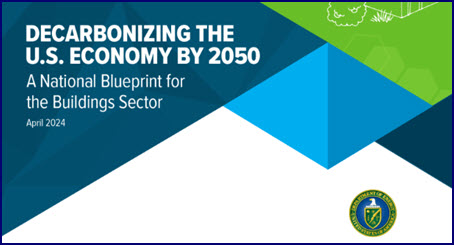
This week, The Roundtable urged the Departments of Treasury, Energy, and the Environmental Protection Agency to develop voluntary, science-based guidelines to help U.S. real estate companies align their climate-related programs with global targets. (July 16 letter)
U.S.-Specific Climate Investment Principles
- The Roundtable’s letter to Treasury Secretary Yellen, Energy Secretary Granholm, and EPA Administrator Regan, builds on Treasury’s Principles for Net Zero Financing and Investment. (Roundtable Weekly, Sept. 23)
- Treasury’s principles can guide net-zero corporate commitments in the United States.
- However, foreign organizations aim to exert significant influence over capital decisions in America’s real estate – which can leave buildings “stranded” in the eyes of some overseas investors because they do not meet “energy requirements being rolled out in Europe.” Bloomberg (June 18)
- These market risks prompted the Roundtable’s letter requesting voluntary building “decarbonization curves” designed by the U.S. government reflecting climatic, market, and data conditions in our country.
- Investment principles for America’s real estate “should not be the creation of the European Union,” The Roundtable states.
- “This is a matter of global economic competitiveness for capital access,” said the Chair of The Roundtable’s Sustainability Policy Advisory Committee, Anthony Malkin (Chairman and CEO, Empire State Realty Trust, Inc.). “America’s buildings should not be expected to meet standards that speak to assets, laws, power grids, and regulatory environments in Europe or elsewhere.”
U.S. Energy Programs and Recommendations

- Malkin continued, “The United States leads the world in government developed, voluntary guidelines for all types of buildings’ energy use and emissions. Agencies like US-EPA and US-DOE know the conditions of our markets, climate zones, and power grids and can help make it easier for capital to come into real estate and grow jobs and tax revenue in the United States.”
- America’s global leadership in developing climate-related real estate guidelines is shown through tools and resources such as:
- EPA: ENERGY STAR Standards for efficient and low-carbon buildings, including NextGen certification. (Roundtable Weekly, March 22)
- DOE: The first voluntary National Definition for a Zero Emissions Building (“ZEB”) (Roundtable Weekly, June 7), and the wealth of scientific research from the agency’s 17 national labs.
- Federal Data Collection: Systems like the national Commercial Building Energy Consumptions Survey (CBECS) and ENERGY STAR’s Portfolio Manager.
- Electric Grid Information: Unmatched resources profiling carbon intensities of grid regions across the U.S.
- The Roundtable urged the U.S. government to develop building “pathways” through a robust public input process that considers the experiences of companies that own, develop, manage and finance America’s real estate.
The Sustainability Policy Advisory Committee (SPAC) will continue to work with the agencies and Congress to shape policies that promote cost-effective investments to optimize building energy efficiency and help the real estate sector mitigate the effects of climate change.









